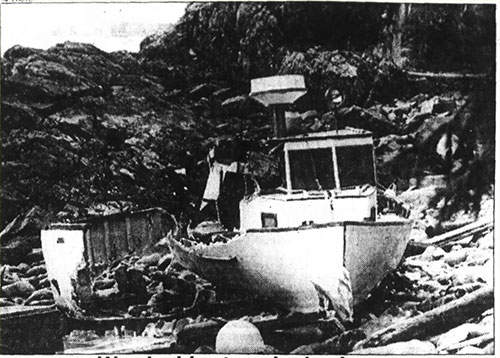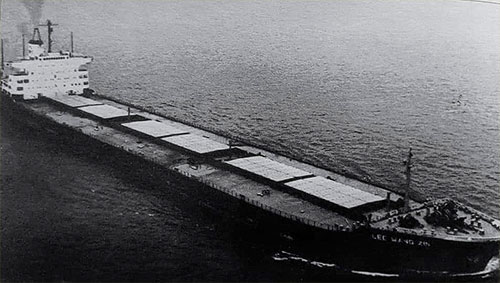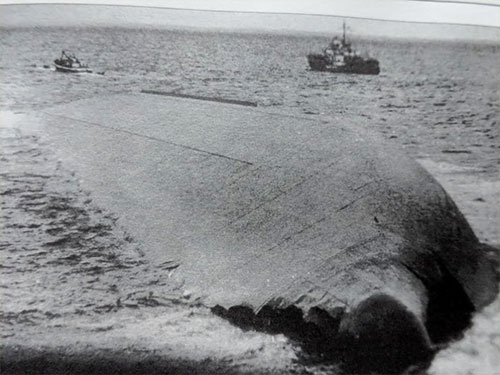A Deadly DecemberTwo shipwrecks in 1979 took 40 lives, Caused largest oil spill before Exxon ValdezBy DAVE KIFFER December 16, 2021
Two ships foundered and 40 people died in those storms. One also caused the largest marine oil spill the state had suffered before the Exxon Valdez went aground in 1988. The first storm was from December 2-5, 1979. According to National Weather Service, it had sustained winds of 60 knots with gusts to 70 knots (80 mph). Waves were estimated at 30-40 feet. Caught in the storm was a 30-foot gillnetter trying to go from Prince Rupert to a small Native village to the north. The Salinta apparently lost steerage in the storm and eventually ran aground near Tree Point, some 40 miles south of Ketchikan. There were 10 people crammed on the 33-foot boat. They all died. Seven of the victims were children.
According to a story in the Dec. 10, 1979 Prince Rupert Daily News, the Salinta left Prince Rupert on Dec. 2, heading for Kincolth (now called Gingolx) a small village near the Alaskan border about 60 miles northeast of Prince Rupert.. On board were the captain, Roy Mostad (44), his three children, Tommy (13), Robert (9), and Tina (9), Judy Stevens (30) and her three children Lyle (7), Nadine (6), and Roselle (4), and Wendy Stevens (27) and her daughter Angie (4). The group had planned to visit relatives at the village and then return later in the day. When they did not return, people in Prince Rupert assumed they had decided to stay longer in the village because of the weather. According to an article in the Dec. 12, 1979 Prince Rupert Daily News, Mostad was not known to tell many people about his comings and goings and it was not unusual for him to be gone for long periods, according to a friend who asked to remain anonymous. But when families didn't hear from the two women on board, they became worried. After there was no word from the boat for three days, relatives called Kincolith and found out the boat had never arrived. They alerted the Canadian Coast Guard on the 5th. A search by both US and Canadian authorities found the Salinta ashore near Tree Point, about 45 miles north of Prince Rupert and a similar distance south of Ketchikan. The boat was broken in half. When rescuers reached the boat, they found three bodies, including Mostad's, still on board. Coastal and dive searches in the following two weeks eventually found four more bodies, but those of three of the passengers were never found. After inspecting the remains of the boat, Canadian and US Coast Guard officials determined that it had lost its ability to steer and that had caused it end up dozens of miles northwest of its intended destination. It was also determined that several of the people on board had died of exposure, indicating that they had likely still been alive when the ship grounded.
The second ship to come to grief in Dixon Entrance that month was the 740-foot ore freighter, the Lee Wang Zin, which had left Prince Rupert with a load of iron ore on Christmas morning and had radioed an SOS that was picked up by the Coast Guard at midday on Christmas Day. Despite the heavy seas, nearly 40 feet, and winds estimated at nearly 90 mph, US and Canadian coast guard reached the location in four hours only to find the ship completely capsized. None of the 30 crew members survived and more than 300 miles of Alaskan coastline was hit by more than 300.000 gallons of oil spilled from the ship. Because of the continuing bad weather -the storm lasted from Dec. 25-28 - rescuers could not immediately approach the ship to check for any survivors in the hull. It eventually grounded near Kendrick Bay on the southeast end of Prince of Wales Island. At that point, hundreds of thousands of gallons of oil began leaking out of the hull of the ship. Most ended up on Prince of Wales Island but currents carried a significant amount north as well and the area around Point Camaano on the Cleveland Peninsula was especially hard hit. When the storm abated, there were extensive searches for crew members from the ship and eventually two bodies were found near Kendrick Bay. But no other crew members were found and it was determined that the ship - which was in danger of sinking because its hull was split - could not be safely entered to look for missing crewmembers. Eventually, it was decided that the best course of action was to attempt to tow the ship 70 miles out to sea and let it sink in deep water. But while it was being towed, not far from Forrester Island, the line parted and the ship sank in 150 fathoms of water. Because the ship came to rest 1,000 feet deep, it was never possible to determine exactly why the hull apparently split and the ship suddenly capsized in the storm.
One guess was offered by the Prince Rupert harbormaster Bob Kitching, who told the Associated Press on December 28th that since the keel was not "uppermost in the water" when the ship was first sighted by rescue planes and it was listing at about 45 degrees it was likely that something that caused the cargo to shift. A Canadian Coast Guard inspector, Guy Thompson, told the AP that there had to had been some structural failure because the ship's hold was designed to prevent just such a catastrophic shift. An inquiry by the Marine Casualty Investigations Department of Transport Canada concluded that the most probable cause of the loss of the vessel was due to her striking Celestial Reef, as she was sailing out of Queen Charlotte Islands area, "which resulted in a massive intake of water through heavy bottom damage by way of the port wing ballast tanks that probably extended through to the engine room. The capsizing was extremely swift, with few of the crew having time to get into their life jackets, and none into life rafts or lifeboats," according to the final Canadian report. But the Canadian authorities conceded that the was no physical evidence the ship hit the reef, which is just about half-way between Dundas and Graham islands. Most of the reef is about 10 fathoms (60 feet) below the surface, according to the Coast Pilot, but one pinnacle does come within about 10 feet of the surface at the lowest tides. Several weeks after the sinking, the Anchorage television station KUAC produced a half-hour documentary on the sinking and the oil spill. The documentary focused on the cleanup, during which Coast Guard and state environmental officials conceded that little of the oil was "cleaned up" and that most ended up being naturally dispersed, albeit very slowly. The cleanup continued well into the summer of 1980 and eventually cost the State of Alaska more than $2 million. The state sued the Japanese company that was chartering the ship, Hokkaido Marine, for reimbursement, but it is unclear how much money, if any, the state got back. There was also a discussion in the documentary about the need for Alaska to have more cleanup resources in the place, especially in Prince William Sound near the Valdez oil terminal. It was noted that a few months before, a supertanker had nearly run aground near Valdez and that - under the current situation - any spill would have had a catastrophic spread. Nine years later, that was exactly what happened. On the Web:
|
|||||||





